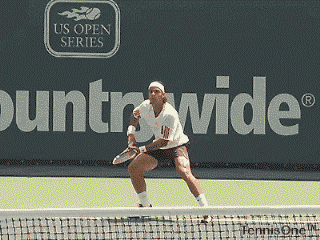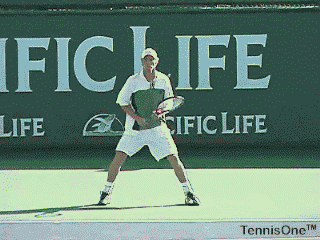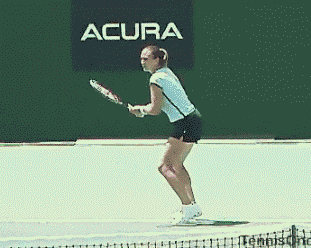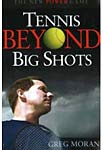| TennisOne Lessons Forget the Strokes, Move Your Feet! Greg Moran Have you ever, in the last twelve months:
If you answered yes to any of the above questions, you may very well be suffering from a compulsive disorder common to tennis players of all ages - Strokeitis. Pronounced stroke-eye-tis, the condition is defined as "a crippling obsession with defining, developing, and refining the perfect tennis stroke." Since the sport was invented, tennis players of all ages and levels have been in search of the perfect stroke and there has always been an endless supply of those willing to oblige us in that quest. We read about the Agassi forehand or the Venus backhand, gobble up the information like a hungry child and then rush to the courts to work on our new stroke. Strokes, strokes, strokes. Enough already! Iím sick of hearing about strokes and their supposed all-importance to a tennis playerís success. If you take a look at the prosí strokes, no two look the same. Some have big looping strokes while others use a more compact, straight-back method. Some use Eastern grips others use Western grips, some hit open stance, others closed. The fact is, there are as many different stroking techniques as there are racquets to choose from and, just as there is no one universal frame for everyone, there is no one ultimate way to stroke the tennis ball. Letís imagine that the tennis ball is a computer. Like the machines you and I are both looking at now, it can do some wonderful things, but it must be programmed to do so. Computers need software and a tennis ballís software is the racquet. The racquet provides this rubber computer with its software in a number of ways, none of which have to do with back swing or follow-through. The Moment of Truth The critical moment of any shot in tennis is the moment of impact and the ball needs two pieces of information at that key time to tell it what to do. The ball needs to know the position of your racquet face and the speed of the racquet head. The ball has no idea what type of back swing you used or what type of grip you are holding and frankly, it doesnít care. Racquet face position and racquet head speed will determine the direction, pace, and spin of the shot, not back-swing and follow-through.
Now, before all of you teaching pros angrily reach for your mouse to hit the e-mail, donít misunderstand me. I am not saying that all of our efforts on stroke production have been a waste. It is certainly important to have efficient strokes that will allow you to present the racquet face to the ball in the desired position at the desired speed and time, and that will hold up under pressure, but I feel that in our quest for the perfect stroking motion, we have overlooked what I feel to be a much more important aspect of tennis, footwork. Contrary to popular opinion, tennis is not a "hitting" game, but rather a "moving" game. By this I mean that tennis is a reactive sport, where one must react quickly in order to respond to a moving object. Thus, a tennis playerís number one priority should be getting into the proper position at the proper time, not refining "classic" stroking motions. Beautiful strokes are absolutely useless if you canít get into position to execute them! Jack Broudy, one of the most successful teaching pros in Southern California, says in his popular book, The Real Spin on Tennis, that "everybody wants to work on their arm motion and their style. However, not enough emphasis is placed on footwork, and that is what probably accounts for 75 percent of peoplesí games, both good and bad." A vast majority of a playerís errors are a direct result not of improper stroking technique, but improper footwork. Jack Groppell, a leader in the field of sport science for years and author of the widely respected book, High Tech Tennis, says that over 70 percent of a playerís errors are caused by bad footwork. In fact, strokes are largely dictated by the player's positioning to the ball. A tennis player can only move their arm in a manner which their body, through proper (or improper) positioning to the ball, will allow. If a player positions himself or herself comfortably, he or she will be able to execute a smooth, controlled stroke. However, improper footwork will lead to improper positioning which leads to a breakdown of the stroke and a loss of control over the shot, not to mention injuries from overcompensation. In other words, stroking is a function of positioning, which is a function of footwork. An example: Bill came to me last week and said, "Iím turning my elbow over on my forehand and hitting every ball into the net. Plus, my arm is killing me." I fed Bill a few balls and sure enough, his elbow turned over on every shot and the ball landed in the bottom of the net. "You see," Bill said. "Iíve got to straighten out my stroke."
I told Bill not to move, and I fed him a few balls to the exact spot it should be relative to his body and told him when to swing. Initially, Bill felt as if the ball was way too far away from him, but after a few balls, he began to get used to the distance and lo and behold, his arm straightened out and he no longer was turning his elbow over. What Bill soon realized was that his elbow turning over was only a symptom of his real problem - faulty positioning! Bill almost always hit the ball late or too close to his body and as a result, turned his elbow over to compensate and fight off the ball which was right on top of him. Given how he had positioned himself, turning his elbow over was the only way his arm could move. Once Bill got a feel of how he should position himself and when he should swing, his crooked elbow straightened right out. Most players simply do not have good footwork and try to compensate by adjusting their strokes. Now, donít confuse good footwork with being a fast runner. Good footwork has virtually nothing to do with speed. Remember, tennis is not a game of speed, but rather quickness and the two are very different. A tennis player very rarely has to move more than a few feet to get into position for a shot, so players must develop very short, quick movements that will enable them to get into the proper position. Speed is generally considered to mean being fast over a longer distance. While there are many players on the pro tour who are probably "speedier" than Michael Chang in a fifty-yard dash, very few are "quicker" when moving three to six feet, which is what tennis requires.
I am not saying that improper footwork is the cause of all of a player's stroking problems. However, I have come to feel that once a player has a good feel for how to swing the racquet for the various strokes, a great deal of their training should be focused on getting their bodies into the proper position. This will then allow them to use the stroking motions they have grooved. A good pro can teach virtually anyone to hit a reasonable forehand or backhand within a few minutes by showing them a basic stroke and then feeding them the ball in the proper position and showing them the timing of the swing. Tennis at that point seems quite easy. Where the game begins to get difficult is when the player is forced to execute the strokes on the move. If they get to the ball early and in the right position they are fine, but more often than not, players arrive at the ball too late and too close to it. Because of that, they spend the rest of the shot trying to get out of their own way, contorting their arms, legs and bodies in some pretzel-like fashion to fight off the ball, hoping to get it back over the net. Over the years I have seen thousands of players stroke the ball beautifully and hit crisp, controlled shots in the warm-up when the ball is fed to them, yet, once the game begins and they have to move to get into position, the beautiful strokes fall apart. They then get frustrated with their strokes and go back to the drawing board (or mirror) in search of a "new" grip or stroking technique. Let me say it once more: A stroke, no matter how beautiful in the mirror, is useless if you are not in the proper position to execute it! Watch the pros, and while youíll see many different stroking techniques, they all do one thing exceptionally well: move their feet. At the moment of impact they are pretty much always balanced and in control. So instead of spending endless hours in front of a mirror executing a perfect forehand, get out the jump rope, and work on your footwork. Your comments are welcome. Let us know what you think about Greg Moran's article by emailing us here at TennisOne.
Tennis Beyond Big Shots presents a bold back-to-the-future approach. A new game that moves away from power and big shots yet is more lethal to opponents than any booming serve. Greg Moran shows players of all ages and abilities that, with simple and small changes, you can not only maximize your tennis wins and play longer, but also have much more fun doing it. Click link to purchase Greg Moran's book, Tennis Beyond Big Shots. |




